- Mike Hoang’s new Goldstripe Maroon Babies were announced moments ago on ReefBuilders. It’s hard to say how excited I was when I stumbled across these baby Goldstripe Maroon Clownfish being turned out by Mike Hoang. I saw them and wondered…if you breed two of these together, will you get Gold Stripe Lightning Maroons?
Of course, it might be very premature to discuss breeding outcomes given that we don’t even know if there’s a genetic component here. However, there’s been no shortage of discussion around what these fish should be called? And yes, just to be clear – no photoshop here – the video of the babies at 3.5 weeks post hatch proves it!
Perhaps even more interesting is that these babies are the offspring of normally-barred captive-bred GoldStripe Maroons:
Initial reports called the fish Teardrop Maroons. Arguably you could say I pursuaded (bullied) Mike away from this name given the prior use of it to describe a common pattern in misbarred Ocellaris Clownfish (not genetic). Mike joked online that maybe they should be called Picasso Maroons. Perhaps a fitting name in my opinion. However, after futher consideration, I would argue that the somewhat Piebald Maroons show off by ORA at the 2010 MACNA are more fitting and similar to the barring pattern displayed by a Picasso Perc, and thus, maybe Picasso might be a good name for that variation.
Mike’s baby Maroon Clowns truly look somewhat like the spotted Amphiprion bicinctus that ORA produces and calls Spotcinctus, a variation that seems to have repeated itself in the fish called the Picasso Clarki Clownfish. Heck, just this morning (9-20-2011), Mike sent photos of a baby he discovered in this batch showing what we’d call a “Pearl Eye” mutation, and this patterning is seen in many of the Spocinctus and Picasso Clarkii.
Similar variations in Maroon Clownfish barring and striping have appeared before from Sustainable Aquatics (SA) and also from wild fish that have been called Horned Maroon Clownfish by SEASMART (the Horned Maroons lacked spotting). If SA already gave their variants a name, it could take priority over anything Mike could want to call them if they’re the same thing.
While waiting to hear back from Sustainable Aquatics, Mike and I discussed the issue of naming, and after some back and forth, in trying to pick something unique, I proffered “it’s a Maroon, right? We have a Lightning Maroon. What about a Hailstorm or Raindrops Maroon?” Mike’s final answer, and a tentative name – Thunder Maroons. Unique and different with a bit of whimsy.
Of course, the discussion continued once we had Matt Carberry of Sustainable Aquatics get back to us – indeed, there was a prior name that SA applied to fish with this phenotype (appearance) –Goldflake Maroons. Matt elaborated on their work with the Goldflake Maroons, writing, “We have seen some aberrant maroons show-up occasionally. The oldest pictures I can find are late 2007; I’m sure that most breeders of maroons on any scale have noticed some of these types of markings. It isn’t extremely common, but we regularly find them in hatches from multiple spawning pairs.” Matt went on to elaborate some initial genetic findings, relaying that they “formed a pair from these, but their offspring have produced only normal maroons (working on the next generation might yield something, but we haven’t explored that). It might be similar to the clarkii pearl-eye or more recent picasso-esque mutation. We have formed pairs of pearl-eye clarkii, but their offspring are no different from normal parents. It seems to be something that happens during larval development.” So the jury is out.
I am the first here to say that this situation has me perplexed. In comparing the “SA Goldflakes” to Mike’s new babies, it is clear that they are similar, but that Mike’s offspring are a more extreme form of the aberration, with more spotting, more irregular and split barring. Mike and I both see the merits of calling his offspring “Hoang Goldflake” – a nod to the preexisting name for what currently appears to be the same basic variation in the same species and a continuation of a process becoming well-entrenched in marine fish breeding (Booyah’s Onyx, Rod’s Onyx, C-Quest Onyx…see the pattern?). So that makes sense for the moment.
It’s fair to say that Matt Carberry would agree that for the moment, “Goldflake” may be a the right name for Mike’s fish. “To be clear about the namings, I am happy that people use any names that we have made and happy if Hoang calls his fish Goldflakes. SA hasn’t and has no plans to trademark a fish/coral name. I’m happy about this too–it makes a consistent presentation to the hobbyist/trade that makes it easier to see what you are getting. We call our fish “SA XXX” just to designate where they were bred versus another breeder working on the same morph. Use of different names for the same morph is confusing to the hobbyist.”
Of course, is it perhaps premature to discuss a name at all? Personally think the name should tentatively stand as Hoang Goldflake until we either see that this is clearly different from the SA Goldflakes, or if we learn this form of misbarring is caused by the rearing conditions and not genetics (in which case these may simply be classified as “ovebarred” vs. “misbarred”).
If in fact Mike’s fish prove to be genetic, or continue to develop a much more extreme variation, it might be very fair to call these fish Goldstripe “Thunder” Maroon afterall, in this case owing to the distinctiveness of the form and being the first proven genetic. But then again, we could very well be looking at simply something analogous to the various gradiations of the Picasso mutation in Percula Clownfish, where we acknowlege they are all Picassos, and show varying levels of misbarring and overbarring across the population that go further and further from the norm. In that case, perhaps Hoang’s Goldflakes represent more “A Grade” Goldflakes vs. the “B Grade” Goldflakes originated, named, and shown in some of Sustainable Aquatic’s earlier images.
Of course, we don’t yet know if the SA Goldflake and Hoang’s Goldflake are the same, but it certainly seems that they could be. Still, there is that outside chance that Mike’s fish could all grow up and look like the Lighting Maroon…
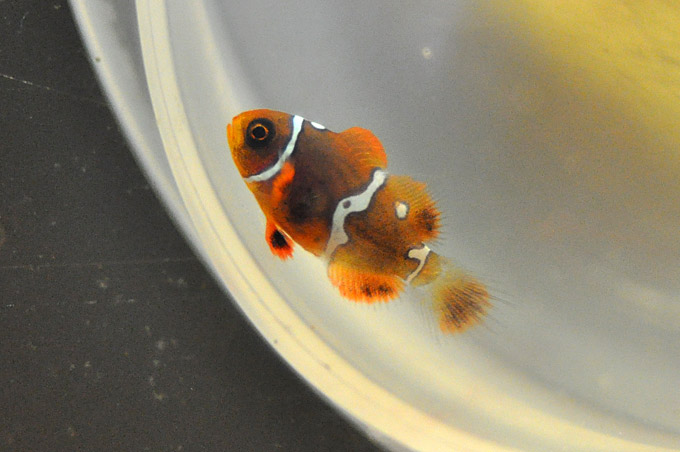
Mike Hoang's Maroon Clownfish, a specimen showing hints of complex patterning - image courtesy Mike Hoang
My personal opinion – if I was to guess how baby Lightning Maroons might look at this age, I’d say Mike’s fish would match my imagination. Seriously – look at that midstripe above…it looks as if the stripe is starting to split and have a dark area in the middle. Take another look at this particular baby from the other side. Could Mike be sitting on a goldmine of baby Gold Stripe Lightning Maroons?
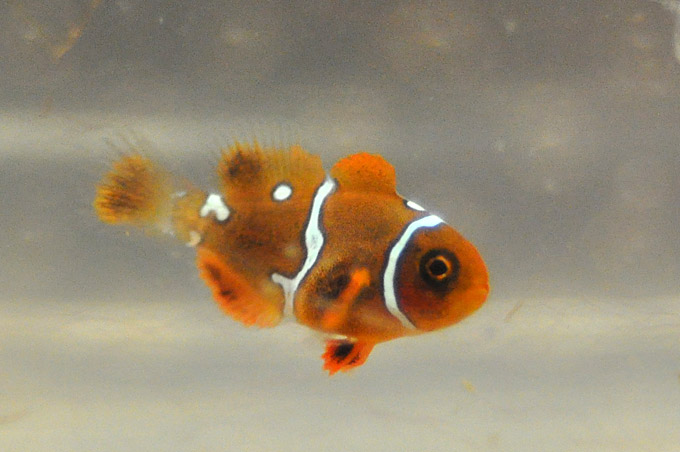
Mike Hoang's Maroon Clownfish, a specimen showing hints of complex patterning - image courtesy Mike Hoang
Time and breeding will tell whether Hoang’s Goldflakes stay named as “Goldflake”, get a new name in “Thunder”, or even somehow wind up being the foundation stock of the Lightning variation in a Goldstripe Maroon population. Until then, our imaginations can wander as we take in these thought provoking photos of Mike’s funky babies. Keep track of Mike’s progress by following his breeding posts over on MARSHReef.com
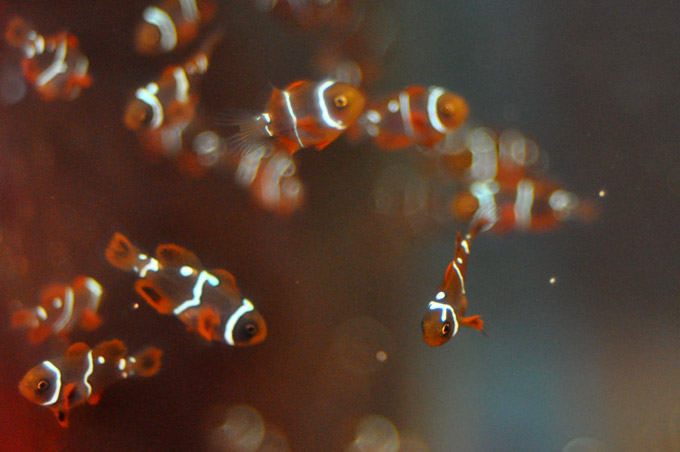
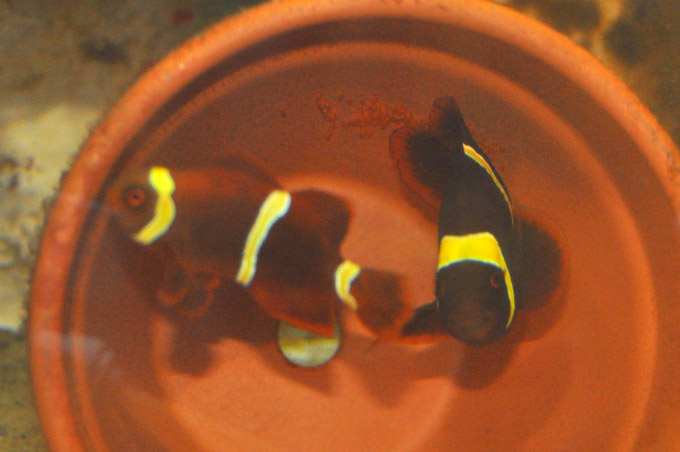
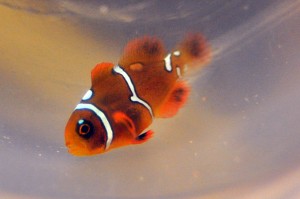

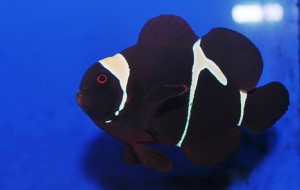
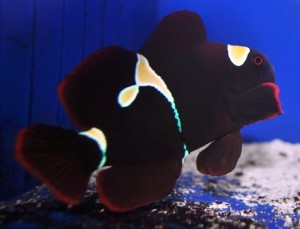
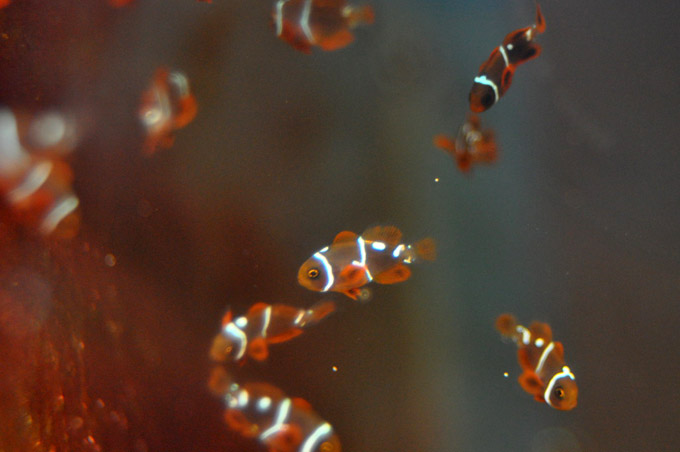
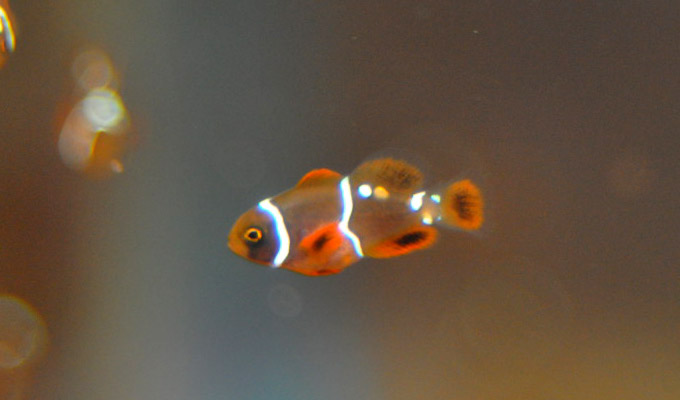
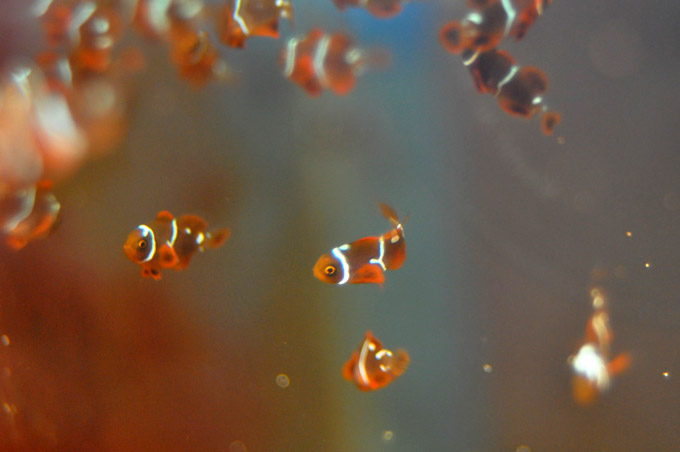
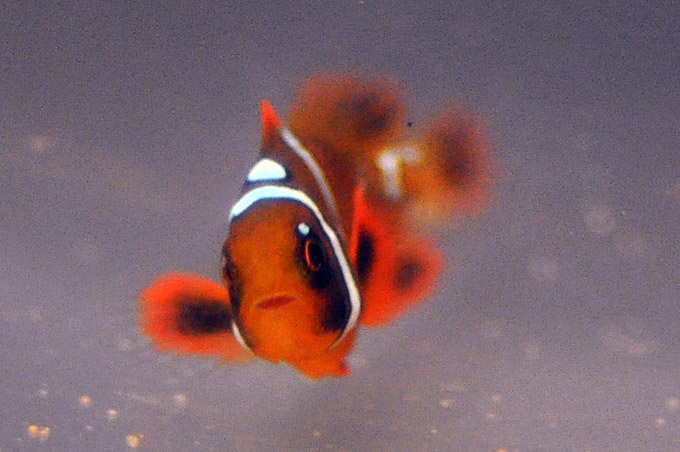

Recent Comments